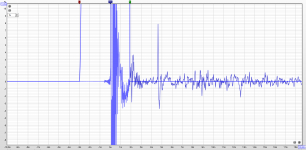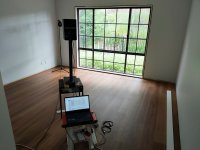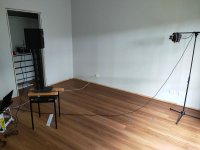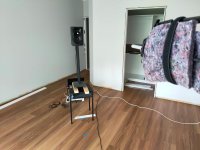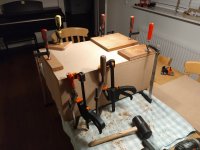I believe you and that's what I meant 🙂
You simply need more room around both WG and the microphone (these two will be at the foci of a reflection-free ellipsoid that you have to squeeze into the room, but that's not necessary to know).
You simply need more room around both WG and the microphone (these two will be at the foci of a reflection-free ellipsoid that you have to squeeze into the room, but that's not necessary to know).
Were you going to use dsp Tom? i use minidsp opendrc da8 myself on a 4 way open baffle - very easy to use - you can make the phase horizontal so woofer en high frequencies do add up perfectly - also is is very easy to even the frequency response, though you also want to take into account the off axis response
Last edited:
Yes, minidsp 2x4hd arrived this week, together with the umik-1.
I don't get what you mean by making the phase horizontal. Could you explain a bit more?
I plan to use it to make to on-axis flat. I designed the waveguide to be 'constant directivity', or slightly climbing. That solves the off-axis problem. The minidsp cannot flatten both at the same time (without a CD waveguide).
I don't get what you mean by making the phase horizontal. Could you explain a bit more?
I plan to use it to make to on-axis flat. I designed the waveguide to be 'constant directivity', or slightly climbing. That solves the off-axis problem. The minidsp cannot flatten both at the same time (without a CD waveguide).
Tom you can jerry rig something out of household objects to get the horn in the vertical center of the room with space around it, this isn't perfect but it should provide some kind of idea. This was an experiment taking measurements along a line so the mic is at the far end of that which isn't ideal for what you are doing.
I think Horizontal phase is another way of saying flat. Either using linear phase crossovers or compensating the excess group delay.
I think Horizontal phase is another way of saying flat. Either using linear phase crossovers or compensating the excess group delay.
Attachments
I ordered a full size microphone stand, but in house measurements will have to wait. The kids are coming back, so I need to clean up the living room and make it a family room again 🙂
In the mean time I will take my impulse response measurements outside, carbide shooting:
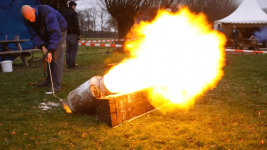
(random image from the net)
I'll wear hearing protection, otherwise all the speaker design effort will be in vain.
In the mean time I will take my impulse response measurements outside, carbide shooting:

(random image from the net)
I'll wear hearing protection, otherwise all the speaker design effort will be in vain.
Happy New Year everybody!
It took me a while to notice that the directivity is high. It is higher than expected around/below 1kHz. I'm having troubles with my crossover design.
The measurement is still plagued by too early reflections. To get to the 6.5ms of reflections free time (mentioned in the asr guide) I will need to go outside. And more importantly, I will need to upgrade my speaker stand.
So I now think I need to get better measurements because of the high directivity instead of building a woofer enclosure.
It took me a while to notice that the directivity is high. It is higher than expected around/below 1kHz. I'm having troubles with my crossover design.
The measurement is still plagued by too early reflections. To get to the 6.5ms of reflections free time (mentioned in the asr guide) I will need to go outside. And more importantly, I will need to upgrade my speaker stand.
So I now think I need to get better measurements because of the high directivity instead of building a woofer enclosure.
With only 2 ms of data there's almost nothing reliable under ~1 kHz. The DI won't be actually that high, that would be too easy 🙂
Based on experience, all should match the simulation quite accurately.
Based on experience, all should match the simulation quite accurately.
yes i meant flat phase, opendrc da8 has fir for thatYes, minidsp 2x4hd arrived this week, together with the umik-1.
I don't get what you mean by making the phase horizontal. Could you explain a bit more?
I plan to use it to make to on-axis flat. I designed the waveguide to be 'constant directivity', or slightly climbing. That solves the off-axis problem. The minidsp cannot flatten both at the same time (without a CD waveguide).
measuring can also be done with mic on the ground, that way you dont get reflections form the ground and other objects might be further away like that
Does anyone have tips to minimize reflections inside the 6.5ms window, so speaker and microphone stand?
Is it possible to position speaker and microphone above each other? What are the pros and cons? How would I make it rotatable?
Does anyone have photo's of their setup?
Any tips I didn't ask for? 🙂
Is it possible to position speaker and microphone above each other? What are the pros and cons? How would I make it rotatable?
Does anyone have photo's of their setup?
Any tips I didn't ask for? 🙂
As has been said, it's all about free space around the source and the microphone.
- In the following picture the direct sound from the DUT (blue arrow) just arrives to the microphone. Now the clock starts ticking and your reflection-free time window lasts until the first reflection arrives. In this case it will be the reflection from the obstacle B, so this is the limit of the setup (which makes the obstacle A irrelevant as its reflection path is longer).

(Typically, the closer you place the DUT and the MIC the longer time window you're able to get.)
- In the following picture the direct sound from the DUT (blue arrow) just arrives to the microphone. Now the clock starts ticking and your reflection-free time window lasts until the first reflection arrives. In this case it will be the reflection from the obstacle B, so this is the limit of the setup (which makes the obstacle A irrelevant as its reflection path is longer).
(Typically, the closer you place the DUT and the MIC the longer time window you're able to get.)
Last edited:
I understand. The ellipse remark a few posts earlier made me understand my thoughts 🙂
That's also why I thought vertical might be interesting. The ground is 2 x height / v away, whereas in the horizontal situation it's less because of Pythagoras.
And unless everything floats (suspend mic on wires?), one needs some support inside the ellipse. Should I use absorption or stealth-airplanes-inspired angled planes? Minimize the area, so use steel tubing iso wooden beams?
That's also why I thought vertical might be interesting. The ground is 2 x height / v away, whereas in the horizontal situation it's less because of Pythagoras.
And unless everything floats (suspend mic on wires?), one needs some support inside the ellipse. Should I use absorption or stealth-airplanes-inspired angled planes? Minimize the area, so use steel tubing iso wooden beams?
I don't get your reasoning here. Typically you want to place both DUT and MIC half way of the room height above the floor, as it's typically the ceiling or the floor that is the closest reflective surface.
Sure, try to minimize the supports inside the ellipsoid but don't be bothered by thin rods or common speaker/mic stands. Some damping certainly won't hurt. I don't use any myself.
Sure, try to minimize the supports inside the ellipsoid but don't be bothered by thin rods or common speaker/mic stands. Some damping certainly won't hurt. I don't use any myself.
I once constructed an XLR-connector on one end of a metal broom stick. That stick fitted onto my mike stand and thus reflections from the mike stand or clip were reduced and delayed.
Are my photos not good enough 😉Does anyone have photo's of their setup?
Any tips I didn't ask for? 🙂
Putting the mic in a longer tube to keep reflections off it interfering is worthwhile some information on my 3D printed parts for that purpose here
https://www.diyaudio.com/community/...aker-build-abec-modelling.357792/post-6759509
A few posts below I snipped an image from a B&K document that shows the effects of different kinds of microphone mounting.
The floor or ceiling is almost always the limiter indoors, it doesn't take much effort with the fixture to reach that threshold. You can try and absorb the floor reflection but to be most effective the absorption needs to gradually increase it's resistance to avoid reflection like an anechoic wedge does.
I did a new measurement with a better setup; only the 90 deg FR. The impulse response was way cleaner and that was visible in the FR (of course). I still had this bump around 700Hz. I think I know where it comes from:
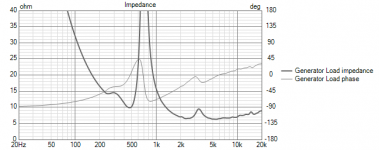
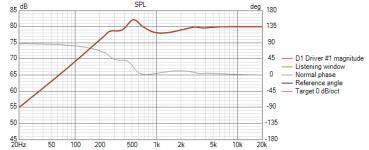
Now I'm thinking: Should I make the impedance flat (especially since I plan on using my tube amp) or don't bother and just flatten it with dsp? What is best practice?
My Faital Pro 12PR320's have arrived. Things are coming together.


Now I'm thinking: Should I make the impedance flat (especially since I plan on using my tube amp) or don't bother and just flatten it with dsp? What is best practice?
My Faital Pro 12PR320's have arrived. Things are coming together.
'Bare metal' prototype enclosure is ready. Kept it as simple as possible: no bracing, no damping, no vents, loudspeaker not recessed. Everything to learn as much as possible.
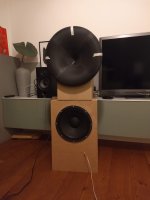
As a first step I measured the impedance of the woofer:
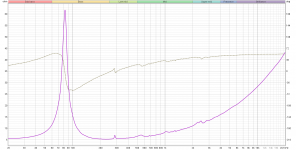
Internal box dimensions (and mode frequency):
Height: 58.4cm (294Hz)
Width: 36.4cm (471Hz)
Depth: 25.0cm (686Hz)
Peaks at 294Hz and 686Hz are clearly present. Cause of other peaks still unknown.
551Hz
1023Hz
1284Hz
2230Hz
2450Hz
2850Hz
Crossover will be around 1000Hz, so I guess these higher ones are not that important.
It looks like I need some damping. What is best practice? What material should I use? I plan to add 2 vents btw.
What other measurements can I do to find more flaws or causes for the other resonances?

As a first step I measured the impedance of the woofer:

Internal box dimensions (and mode frequency):
Height: 58.4cm (294Hz)
Width: 36.4cm (471Hz)
Depth: 25.0cm (686Hz)
Peaks at 294Hz and 686Hz are clearly present. Cause of other peaks still unknown.
551Hz
1023Hz
1284Hz
2230Hz
2450Hz
2850Hz
Crossover will be around 1000Hz, so I guess these higher ones are not that important.
It looks like I need some damping. What is best practice? What material should I use? I plan to add 2 vents btw.
What other measurements can I do to find more flaws or causes for the other resonances?
- Home
- Loudspeakers
- Multi-Way
- Efficient 2-way
